Você quer saber como criar categorias e subcategorias no WordPress?
No WordPress, suas postagens podem ser organizadas em diferentes categorias e tags. Você pode até mesmo criar subcategorias para maior organização. O uso de categorias e subcategorias pode ajudar seus leitores a encontrar o conteúdo que mais lhes interessa e melhorar as classificações de SEO do seu site.
Neste artigo, mostraremos a você como adicionar facilmente categorias e subcategorias no WordPress, passo a passo.
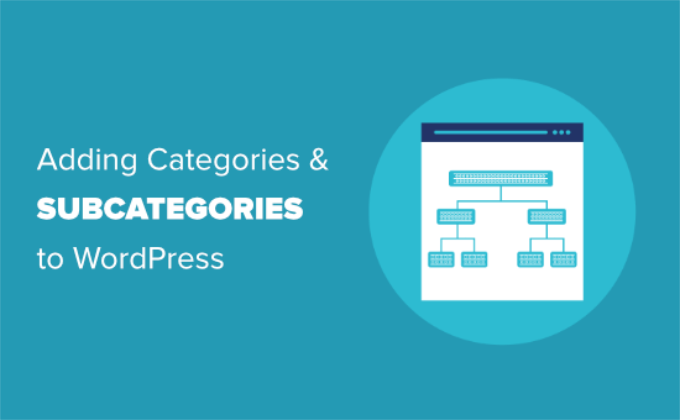
Entendendo as categorias pai e filho no WordPress
As categorias são uma ferramenta poderosa. Elas não são apenas uma maneira de classificar seu conteúdo. Elas também ajudam você a desenvolver uma estrutura de site adequada que seja significativa e semântica. Isso é ótimo para o SEO do WordPress.
Observação: Se você não souber a diferença entre categorias e tags, dê uma olhada em nosso guia sobre categorias e tags. Ele explica por que as categorias e as tags são diferentes e como usá-las corretamente.
Agora você deve estar se perguntando: por que e quando alguém precisaria usar categorias secundárias (subcategorias) em seu site WordPress?
Digamos que você esteja criando um blog de viagens para diferentes destinos ao redor do mundo. Talvez você queira que os usuários possam encontrar artigos por país e cidade.
Por exemplo, você pode ter um artigo sobre os melhores parques aquáticos dos Estados Unidos. Faria sentido usar “Estados Unidos” como a categoria para essa postagem.
Entretanto, você também pode ter artigos sobre os melhores lugares para comer na cidade de Nova York, Los Angeles, Chicago e outros. É aqui que você pode usar subcategorias ou categorias secundárias. Então, “Estados Unidos” pode se tornar uma categoria principal e as cidades podem se tornar categorias secundárias.
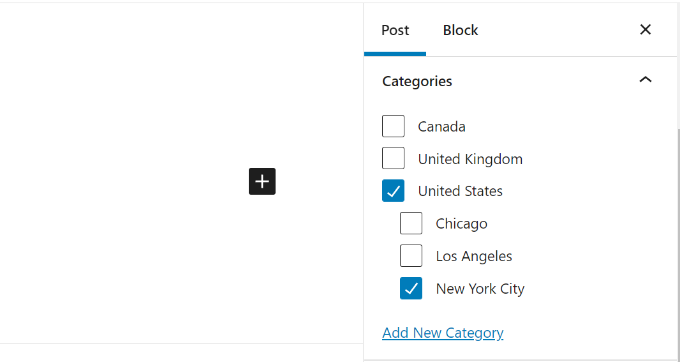
Uma postagem arquivada em uma categoria secundária não precisa ser arquivada também na categoria principal. Em nosso exemplo, poderíamos ter deixado a opção “United States” desmarcada e colocado a postagem na categoria “New York City”.
Se você arquivar uma postagem na categoria secundária, mas não na categoria principal, sua postagem aparecerá somente nas páginas de arquivo da categoria secundária.
Dito isso, vamos dar uma olhada em como adicionar categorias regulares e categorias secundárias no WordPress.
Como adicionar uma categoria no WordPress
Você pode adicionar facilmente uma nova categoria no WordPress ao escrever um post.
Primeiro, se a barra lateral não estiver sendo exibida quando você estiver editando uma publicação, será necessário clicar no ícone de engrenagem no canto superior direito.
Em seguida, no painel de blocos no lado direito, abra a guia Categories (Categorias).
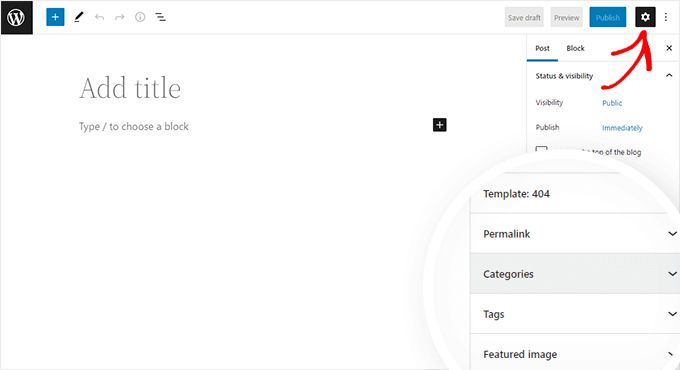
Você verá diferentes categorias que já criou.
No entanto, para criar uma nova categoria, você pode simplesmente clicar no link “Add New Category” (Adicionar nova categoria).
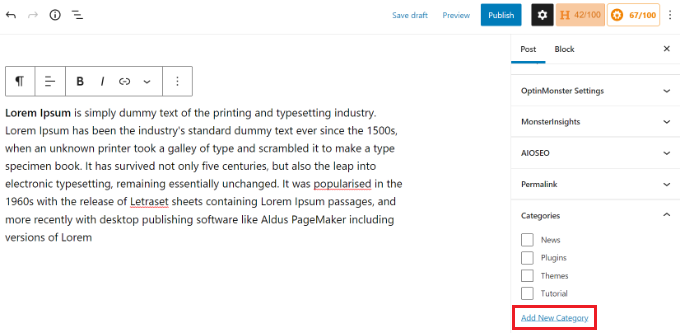
Depois de clicar no link, serão exibidas duas novas caixas nas quais você poderá adicionar sua categoria.
Para uma categoria normal, você não precisa selecionar nada no menu suspenso Parent Category (Categoria pai).
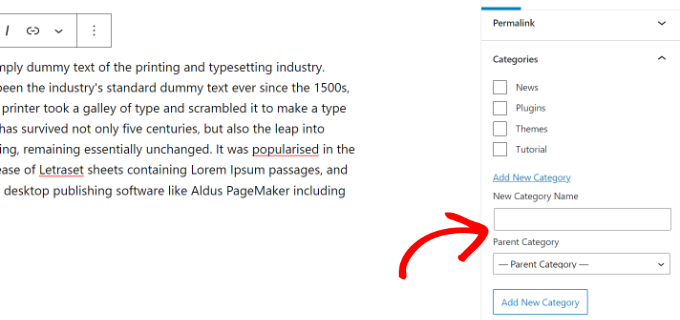
Depois de digitar o nome da sua categoria, basta clicar no botão “Add New Category” (Adicionar nova categoria).
A caixa dessa categoria será automaticamente marcada para sua postagem atual. Você pode desmarcá-la, se desejar.
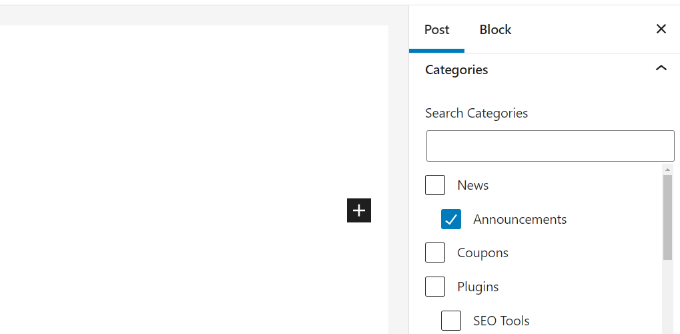
Você também pode adicionar uma nova categoria sem editar uma postagem.
Basta acessar Posts ” Categories e adicionar sua nova categoria. Isso é útil se você quiser criar todas as suas categorias antes de adicionar conteúdo.
Esse método também permite que você edite o slug (URL) das suas categorias. Você pode excluir e renomear categorias e dar a elas uma descrição. Veja como adicionar palavras-chave e descrições de SEO no WordPress.
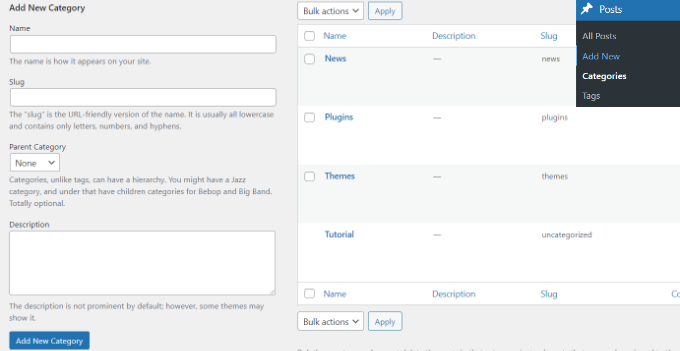
Adição de uma categoria secundária (subcategoria) no WordPress
Você pode adicionar e editar categorias secundárias exatamente da mesma forma que adicionou as categorias principais.
Quando estiver editando uma postagem, abra o painel de configurações e role para baixo até a guia Categories (Categorias).
Em seguida, clique na opção “Add New Category” (Adicionar nova categoria) e digite o nome de sua categoria secundária. Em seguida, selecione a categoria que você deseja usar como a principal na lista suspensa.
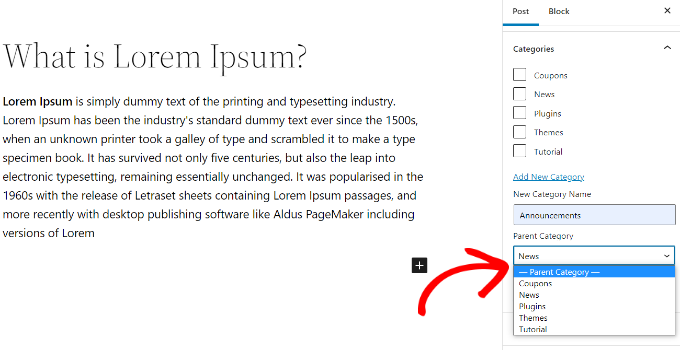
Da mesma forma, você também pode ir para Posts ” Categories para adicionar categorias secundárias.
Basta digitar o nome de sua categoria secundária e selecionar a categoria principal no menu suspenso.
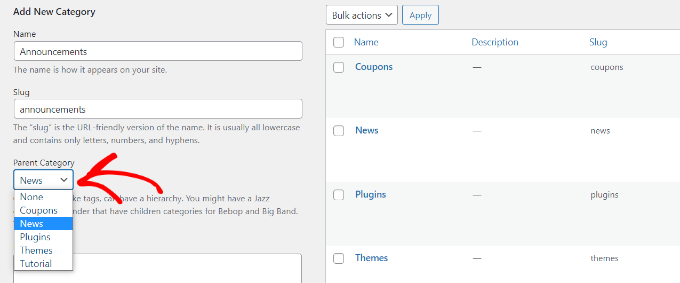
Suas categorias secundárias também podem ter suas próprias categorias secundárias, se você desejar.
Por exemplo, podemos decidir desenvolver uma estrutura de categoria que seja usada para agrupar vários tipos de conteúdo, como esta:
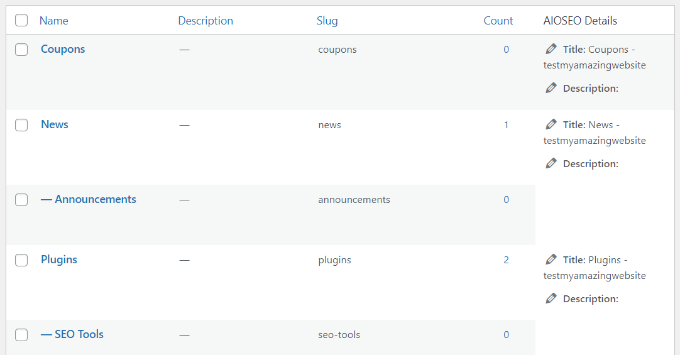
Aqui, Notícias é uma categoria, com os Anúncios como categorias secundárias.
As categorias no mesmo nível dentro de uma categoria principal às vezes são chamadas de categorias “irmãs”. Por exemplo, os Anúncios e as Ferramentas de SEO são categorias irmãs aqui.
As categorias só podem ter uma categoria principal. Não é possível adicionar uma subcategoria em duas categorias principais diferentes.
Benefícios de SEO da estrutura do site baseada em categorias
Os URLs de sua categoria terão a seguinte aparência:
https://example.com/category/united-states/new-york-city/
Isso é significativo e ajuda os mecanismos de pesquisa e os visitantes a entenderem do que se trata a sua página. Você também tem a chance de adicionar palavras-chave ao seu URL. As palavras-chave ajudam as pessoas a encontrar conteúdo nos mecanismos de busca.
O WordPress também permite que você altere facilmente o prefixo /category/ dos URLs de suas categorias. Você pode até mesmo removê-lo completamente, se desejar.
Basta acessar a página Configurações ” Permalinks no painel de administração do WordPress e rolar para baixo até a seção “Base da categoria”.
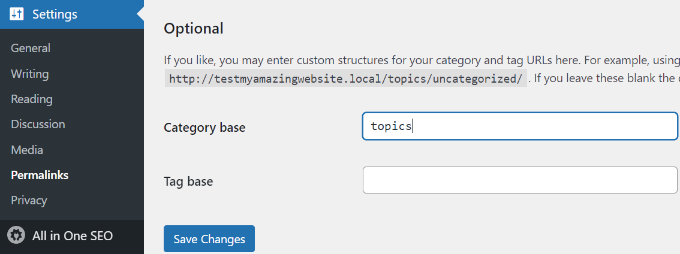
Aqui você pode inserir o prefixo que deseja usar e clicar no botão “Save Changes” (Salvar alterações) para armazenar as alterações.
O prefixo “category” em seus URLs de categoria não acrescenta nenhum benefício ao seu SEO.
É por isso que alguns proprietários de sites preferem remover a palavra “categoria” dos URLs de suas páginas de arquivo de categoria do WordPress. Você pode fazer isso facilmente usando o plug-in All in One SEO, para que os URLs de suas categorias tenham a seguinte aparência:
http://example.com/united-states/new-york-city/
Basta acessar o menu Search Appearance do AIOSEO e selecionar a guia Taxonomies (Taxonomias). Nas configurações avançadas de Categorias, você verá a opção de remover o prefixo da base da categoria.
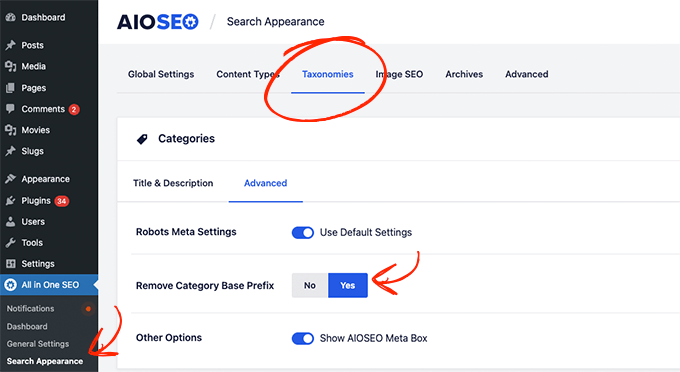
Como alternativa, você também pode usar o plug-in FV Top Level Categories. Basta instalar o plug-in e ele removerá a palavra “categoria” dos URLs de suas páginas de arquivo de categoria.
Importante: se você decidir alterar a base da categoria em um site existente do WordPress, precisará configurar redirecionamentos para evitar erros 404 para os visitantes do mecanismo de pesquisa. Para obter instruções mais detalhadas, siga nosso guia sobre como alterar o prefixo da base da categoria no WordPress.
Como exibir categorias e categorias secundárias na barra lateral do WordPress
Você pode adicionar um bloco de widget à barra lateral ou ao rodapé do WordPress para mostrar uma lista de categorias. No painel do WordPress, vá para Appearance ” Widgets.
Se você não tiver alterado seus widgets em relação aos que o WordPress coloca por padrão, deverá ver o bloco de widget Categorias já instalado. Caso contrário, você pode clicar no botão “+” e adicionar um bloco “Categoria” à sua área de widgets.
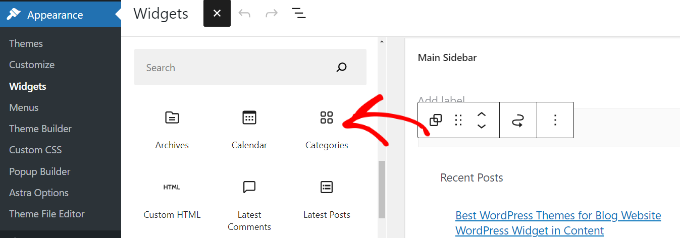
Por padrão, o widget mostrará todas as suas categorias em uma lista simples, em ordem alfabética.
Aqui está uma prévia de como eles ficaram em nosso site de teste:

Dica: As categorias só serão exibidas na lista se você tiver atribuído pelo menos um post publicado a elas.
Você pode alterá-lo para mostrar as categorias secundárias (subcategorias) abaixo de suas categorias principais, se desejar. Basta ativar a opção “Mostrar hierarquia” nas configurações do widget desta forma. Não se esqueça de clicar no botão “Atualizar”.
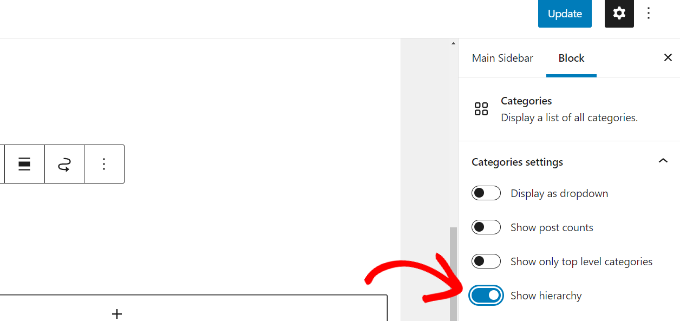
Em seu site, agora você deve ver as categorias principais com as categorias secundárias aninhadas abaixo delas.
Dica: se as alterações na barra lateral não forem exibidas, talvez seja necessário limpar o cache do WordPress.
Além do bloco de widget de categoria padrão, você também pode criar links de menu de categoria personalizados usando o menu de navegação do WordPress. Depois disso, você pode adicionar esse menu ao menu do cabeçalho, à barra lateral, ao rodapé ou a outros locais de menu.
Bônus: Exibir subcategorias em páginas de categoria no WordPress
Depois de adicionar subcategorias ao seu site, você poderá exibi-las nas páginas de categoria. Isso facilitará a navegação dos usuários pelo seu conteúdo e poderá aumentar o tráfego.
Para exibir subcategorias, você deve adicionar o seguinte código personalizado ao arquivo category.php. Você pode encontrar essa pasta nos arquivos do seu tema.
<?php
if (is_category()) {
$this_category = get_category($cat);
}
?>
<?php
if($this_category->category_parent)
$this_category = wp_list_categories('orderby=id&show_count=0
&title_li=&use_desc_for_title=1&child_of='.$this_category->category_parent.
"&echo=0"); else
$this_category = wp_list_categories('orderby=id&depth=1&show_count=0
&title_li=&use_desc_for_title=1&child_of='.$this_category->cat_ID.
"&echo=0");
if ($this_category) { ?>
<ul>
<?php echo $this_category; ?>
</ul>
<?php } ?>
Depois de fazer isso, basta visitar qualquer página de categoria em seu site, onde você verá uma lista de suas subcategorias que os usuários podem navegar.
Para obter detalhes, consulte nosso tutorial sobre como exibir subcategorias em páginas de categoria no WordPress.
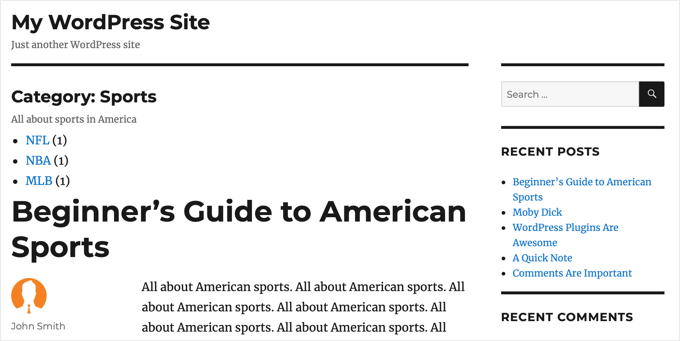
Esperamos que este tutorial tenha ajudado você a aprender como adicionar categorias e categorias secundárias no WordPress. Talvez você também queira dar uma olhada em nosso artigo sobre como criar um boletim informativo por e-mail para aumentar o tráfego do seu site e em nossa comparação dos melhores construtores de páginas do WordPress para criar layouts personalizados.
Se você gostou deste artigo, inscreva-se em nosso canal do YouTube para receber tutoriais em vídeo sobre o WordPress. Você também pode nos encontrar no Twitter e no Facebook.





Syed Balkhi says
Hey WPBeginner readers,
Did you know you can win exciting prizes by commenting on WPBeginner?
Every month, our top blog commenters will win HUGE rewards, including premium WordPress plugin licenses and cash prizes.
You can get more details about the contest from here.
Start sharing your thoughts below to stand a chance to win!
Atul Tanna says
I have a Buying Guide, Review, and Categories and Under Categories I have several sub categories
When I Review Amazon Products I would like them to appear under Reviews and at te same time time I would like them to appear in one of the sub categories How do I get started and what do I do
Thanks
WPBeginner Support says
Unless your theme specifically hides them, your category pages should include any subcategories in the list of posts. You can create the category pages by linking to your category in your menu and our guide below should help create your menu!
https://www.wpbeginner.com/beginners-guide/how-to-add-navigation-menu-in-wordpress-beginners-guide/
Administrador
Alaba says
Hi, my site has some categories that don’t have any parent category. However, these were created a long time ago. Can I just assign them one?
WPBeginner Support says
You can but if you have any posts under the categories, be sure to redirect any posts that had their URLs changed
Administrador
Ayo says
Hi, How can I have a parent category that covers all the posts of its subcategories like the one on this web (https://www.wpbeginner.com/blog/)?
WPBeginner Support says
That would be your posts/blog page that you can set under Settings>Reading
Administrador
Imran khan says
When using child categories, should I check the parent category also checked, or keep it unchecked?
WPBeginner Support says
If you mean when adding a post to the category, you would only need to check the child category
Administrador
Imran khan says
I have my permalink structure set to “/%category%/%postname%/” and I want to show the parent category in my URL.
1. If I checked the child category my post URL’s are showing: “www.my-site.com/parent-cat/child-cat/post-name/”
2. If I checked both child and parent categories, my post URL’s are showing: “www.my-site.com/parent-cat/post-name/” that I want. So now should I check the parent category also checked, or keep it unchecked? If i checked both then it would not be an issue to have duplicate content that will negatively affect on SEO.
WPBeginner Support says
Your URLs are like that as your parent category would be used first. It should not affect your SEO but you can use both categories if you wanted. Otherwise, we would recommend taking a look at the recommendations from our article below:
https://www.wpbeginner.com/wp-tutorials/how-to-change-the-category-base-prefix-in-wordpress/
Terry says
Can subcategories be used for products?
WPBeginner Support says
Yes, as long as your eCommerce plugin allows.
Administrador
Sade says
Hi,
I have made my catergory showing at the top a drop down, but when I put category in my primary sidebar when I click it says ‘select category’ and doesn’t show my sub categories. How do I fix this?
Thanks
WPBeginner Support says
You would normally need to manually add subcategories if we’re understanding what you’d want correctly.
Administrador
Ebi says
Hi
Can I generate multiple articles for the main category without selecting a subcategory for it (with a few subcategories), is this SEO desirable?
WPBeginner Support says
You can have multiple posts in one category if you wanted and not use subcategories, it would depend on the overall organization of your site for how useful it would be and if it would have any SEO effect.
Administrador
usman says
hay i need to know how i display sub-category show in menu when i add new show auto into the menu
WPBeginner Support says
For customizing your menu, you would want to take a look at our guide below:
https://www.wpbeginner.com/beginners-guide/how-to-add-navigation-menu-in-wordpress-beginners-guide/
Administrador
Candy says
I have six categories on my homepage. When you click the image on the homepage, it takes you to that category page. I am having an issue with blog posts. How do I get the blog post to automatically appear on the correct category page? I’m been doing this manually and I know there has to be another way. Thanks in advance!
WPBeginner Support says
You should be able to link to the category page for WordPress to automatically list the posts in a category. You can get the link to your category page by adding a category to your menu. You should not be manually creating your category pages.
Administrador
Stef says
You mentioned if you don’t attach the item to the parent and only the child that it wouldn’t show up in the parent. This is incase you don’t want duplicate content.
If left attached to both would this create an SEO issue of having duplicate content then? I know Google frowns upon duplicate content, but you didn’t say.
Thanks in advance.
WPBeginner Support says
It should not cause a duplicate content issue either way.
Administrador
Muhammad Salman says
Good. It helped me a lot thanks wpbeginner
WPBeginner Support says
You’re welcome, glad our article was helpful
Administrador
Julie says
Thanks,
I was told I was creating my categories incorrectly as they had the word ‘category’ in the URL. I read several posts on how to create categories and yours was the only one explaining this.
That said, how bad is it to have this? I hate to add in yet another plugin. It really doesn’t bother me…unless it should for some reason.
Julie
WPBeginner Support says
There is a large amount of personal preference as search engines don’t specify their preference other than being easy for users to understand. You can always update your category names if you wanted but it is not a hard requirement. For adding more plugins, for the most part, you shouldn’t worry. For our guide on plugins you would want to take a look at our article here:
https://www.wpbeginner.com/opinion/how-many-wordpress-plugins-should-you-install-on-your-site/
Administrador
Steve says
Is there a way to filter the categories? Id like to show the categories related only to this page topic.
WPBeginner Support says
For what it sounds like you’re wanting, you may want to take a look at our guide on adding conditional logic to menus: https://www.wpbeginner.com/plugins/how-to-add-conditional-logic-to-menus-in-wordpress/
Administrador
Anna Tang says
Thank you for the tutorial. It was clearly written and I solved my category/subcategory issues within 5 minutes.
Best,
Anna
WPBeginner Support says
Glad our article could help
Administrador
Kelly Quek says
Hi I need help.. I have accidentally click on make a default.. How to undefault it back?
WPBeginner Support says
You can change which category is the default under Settings>Writing but you must have at least one default category
Administrador
Michael Taylor says
Is it possible to create a hierarchy with lets say parent, child, grandchild , and great grandchild? in other words…
United States > California > San Francisco > Hotels
United States > Nevada > Las Vegas > Hotels
United States > New York > New York City > Hotels
Canada > British Columbia > Vancouver > Resturantrs
WPBeginner Support says
Yes you can have multiple subcategories beneath a subcategory if you wanted
Administrador
dinesh says
How can I represent woocommerce categories, subcategories, and products in the form:
1) A form consists of 3 fields categories, subcategories, and products
2)If we select one category the related subcategories should be displayed in subcategories feild.
3)Select Subcategory , such that the product should be displayed by related categories and subcategories
4) And if we submit the form It should redirect to checkout page
WPBeginner Support says
Rather than in a form, you may want to take a look at the plugin in our article: https://www.wpbeginner.com/plugins/how-to-let-users-filter-posts-and-pages-in-wordpress/
Administrador
sera says
Hi
i have a problem
i want to associate one subcategory to a few parents
for example:
outdoor > panel
indoor > panel
outdoor & indoor is parents and panel is a child
can you help me please??
thaks a lot
Usama Ahmed says
That is the most basic example of many to many relationship inside categories. One Category with multiple parents.
Unfortunately WordPress is a pile of garbage and till this date this feature is not available.
Sunshine Vaughn says
I don’t want all of my posts to show when i click on the parent. How do i go about fixing this?
I only want to see the posts directly placed in each category and then list out each sub category just like you would in using Windows Explorer.
Thank you,
Sunshine
Mike says
I’m helping a friend switch update their website, and upon investigation they built it mainly from categories and sub-categories, with only four (unfinished and unlinked) pages and the reading setting as show recent posts, instead of having a static homepage. The main menu displays categories with sub categories highlighted underneath.
My question is, what’s the best way to update the site, by adding a static homepage and other primary pages for the posts to be listed with without messing with the overall organization of the content?
Denis says
How can we add a third level of subcategory in Woocommerce ?
Bhat Muzamil says
It was very helpfull to me thanks for such a awesome article
Bel says
Hello, awesome site. Thank you you have helped me to build my website.
I have question hoping you can help – is there an plugin to place small images left side of post summaries on landing page.? I have looked and searched and even paid for a plugin that did not operate. Any help would be great.
Steven Denger says
Very helpful like all your tutorials are. I always come here to learn the best practices as well as great plugin resources. Thanks for this tutorial.
Stefan says
So… what is a sub-category good for?

I can just have “United States” and “New York” — both as categories, and simply drag “New York” under “United States”. They’ll be displayed the same, as category / subcategory, only that they’re both categories.
I can choose if an article goes to both, or just one of the categories.
So, what is the use of having a subcategory?
WPBeginner Support says
Hey Stefan,
Subcategories allow you to add subtopics to a category. An article, filed in a sub-category is also displayed in the parent category. However, an article filed in a sibling category will not be displayed on other sub-categories that are also part of the same parent category.
Administrador
Vijeesh Vijay says
Duplicate content is the major issue when assigning posts to both parent categories and child categories. For example, I want the same post to show up under “united states” parent category and “New York” child category. However I need more than 1 post in each child category to avoid duplicate content.
The problem occurs when you have a menu or website navigation made of categories. You have to wait until the blog is big enough to have a few articles in each sub categories to make a proper menu. Is there a way around this ?
Anja says
Hi VIJEESH,
It shouldn’t be a problem. The url of the page/post remains the same, it is mentioned in the category page and Google recognizes this, their bots are really intelligent To avoid it even better I suggest you install YOAST SEO, a free plugin, which is great for your SEO and they offer the option to avoid duplicate content from categories as well in the settings menu.
To avoid it even better I suggest you install YOAST SEO, a free plugin, which is great for your SEO and they offer the option to avoid duplicate content from categories as well in the settings menu.
Hope this helps!
Anja
rose says
hi guys!
I’ve been working on my website and for days I’m trying to figure out on how to work the sub menus on my two blog categories namely lifestyle and tv series- the 1st submenu is working out fine but the 2nd level up to fourth level- I can’t click it al all.
i’ve tried plugins and all
is there anyone can help me with this please? Thanks so much
sincerely,
rose
Jill says
Great article. This was a HUGE help!
Question:
You explained how to get the child categories to show on the blog sidebar but how do I get them to show on the top bar as drop downs?
vivek says
To do this go to Posts -> All Posts. Next, select the posts you want to add to a category, click on the Bulk Actions tab, select Edit and finally press the Apply button. Once you do that, you will few options you can adjust for those posts. One of them is the Categories section.
Harish Negi says
I am using category and subcategory, but they are not reflecting in my URL. is there any reason for that in wordpress. Please answer..
evan says
I would like my category pages to show the sub-category PAGES that belong to that post. Currently, my category pages are show the subcategory POSTS.
How do I fix this?
Alex says
Great read, thanks!
I am creating a website with the exact same example you gave. I am wondering if it’s better to have the permalink structure set to:
1. /continent/country/destination/%postname% or to
2. /%postname%
I am not sure if the first option is better, since it is becoming quite long.
Thank you for your help!
Nicole says
What if you want the category’s to be going across the top of the page and not on the side?
Mikey says
Thanks for the help!
Urooj says
Thank you for this post. I understand the category and the sub categories you explained. There si something I want for the my website. I make a category for a course with the course name now for the sub-categories, say, I want books, audios, videos and flashcards also I want a page which shows all the books from all the categories I have on a single page. Same for the audios, videos and flashcards. Is that possible without duplication?
Jason says
Is it possible to have multiple subcategories with the same name? For example, to categorize counties in the United States as State -> County. I would like Mississippi -> Jackson but also Alabama -> Jackson. Jackson county exists in both states, but should be entirely unrelated. Any way to accomplish this?
Rolfa Stol says
I add category per easy instructions above ( visit POSTS–add new category..) and the added show up to the right, correctly as far as i can see, but not on main page under categories. Impossible to get it there, only the default “uncategorixed” show up there. Really strange, as i need to use Kudani and make a post on distance, but it also seems to think i have no category…..
WPBeginner Support says
Simply creating a category is not enough. You may also need to assign atleast one post to that category. By default, WordPress sometimes does not display empty categories.
Administrador
Anca says
Great info! Thank you very much!! I finally managed to create a sub-category
WPBeginner Support says
Glad you found it helpful.
Administrador
Suzy says
Dear staff,
What if I want to display my 2 subcategories on their parent category page?
I know that there is some sort of code, but where exactly should I paste this code, in the functions.php?
Thank you
evan says
I have the same question. Please let me know if you found an answer
Ian Anderson says
Hiya, thanks for the tutorial.
Any tips where categories overlap? For example my DIY site often features stuff made from wood but also repairing or maintaining stuff made from wood. Do I categorize ‘wood’ or ‘repair’ / ‘maintain’.
Plus different materials (metal/tile/fabric etc) so I’m really struggling to know what to put first, material or action?! Either way it looks like I’m going to have duplicate subcategories…
Sometimes wish I had a needle narrow skillset lol!
Kaye says
Is there a limit on categories? I currently have 10 displayed but have 12 listed so two is not showing up. Is there a way to add more so that the last two will show up. When going to my site live I see the two space on the third row but they are not showing up. What am I doing wrong
WPBeginner Support says
By default, WordPress does not show empty categories in the category lists. Please see our guide on how to show empty categories in WordPress widgets
Administrador
Elliot says
Is there a limit to the amount of categories enabled on word press?
I have a large amount of subcategories and wordpress won’t allow me to add anymore, it seems to just boot an old category out in order to make space for the new one?
Can anybody help?
Rahul Choudhary says
Hi Syed
Thanks for this article. The example you have given here is exactly the same scenario i am dealing with. Now here is situation I have Categories
Parent Category : Australia
Child Category: NSW
Child Child Category : Sydney
I also have three more Parent categories at same level as Australia
Apple
Microsoft
Other
Now when I create a post I assign Parent & child categories because I am using ajax search to filter the result on hierarchy based. I also select one of those parent categories as well : Apple, Microsoft or Other.
Now I have a search box where I sort the result based on country city or town. I would like to have a one more search box where I could sort based on Apple, Microsoft or others where once I select apple then it should display Australia -> NSW -> Sydney.
Its like country (parent) category will be a child category in this search.
Is this possible?
Thanks
Rahul
WPBeginner Support says
Take a look at SearchWP plugin. It has a taxonomy filter that might work for your scenario.
Administrador
francis okoye says
Thanks for d tutorials was really helpful. How can I make my subcategory to appear when the mouse is hovered on the category. I don’t want the subcategory to show beneath the category. I want it to show on hovering the category…. Any help please
Rahul says
Hi
I am having real problem sorthing this category issue. I want to display hotels & Car Rental in various countries so:
Country
-> US -> Alabama -> Montgomery
-> Australia -> NSW -> Sydney
Country is the ultimate parent category I would like to have.
Then I would like to display either all the hotels or Car Rental in that particular city.
So basically countries will have both hotels and car rentals but I would like to display hotels only in Sydney if user decided to display hotels only or car rental.
Help Needed.
Cheers
claude apetse says
hello admin , i found very interesting post in your tag. but in my , the first day after hosting the site (wordpress) i added some category but after a while ( some days after) i could no longer add new category . it is adding of course in the category form when i fill it but not showing in the homepage of the site
WPBeginner Support says
A category will not appear on your site until you publish a post in that category.
Administrador
Chris says
Are the categories you mention in this post only applicable to POSTS, or can categories be added for PAGES as well? I don’t see an option for creating a category for PAGES.
WPBeginner Support says
By default pages cannot be categorized. See our guide on the difference between posts and pages. However, you can use a plugin to make categories and tags available for pages as well.
Administrador
Ruby says
I really needed this tutorial! Thank you so much for making it so easy to understand.
sandeep Kumar Dan says
Hi, Sayed
Great article , its really helpful , I was doing an product listing project . Where i was need many category subcategory option , finally I did it with this tutorial. Thanks a lot
sue says
I have added another sub category to an existing list and it does not show up on the blog page?
TIA